Freedom had never felt so real—and so loaded with irony. As I drove to our new office opposite Arthur Road Jail each morning, I often got stuck in traffic. A police van, heavy with undertrials, would frequently partly block the road, its grim cargo staring out through rusted bars. There I was, reveling in the thrill of my newfound freedom as an entrepreneur, yet passing the starkest symbol of confinement daily. It was impossible not to feel the pull of these opposing forces—the heady excitement of building something new and the weight of uncertainty that the undertrial van would instill in me.
The office itself, a far cry from the grandeur of HDFC Bank’s Paragon Centre, was bare and functional. There were no sweeping glass walls or plush carpets—just a small functional space where every decision felt monumental.
Every rupee was scrutinized, and every hire was made with the unspoken hope that, somehow, belief would outlast the odds. Some mornings, I’d arrive brimming with ideas, convinced that Cequity was on the brink of something extraordinary. By evening, doubt would settle in—was I being reckless, dragging others into a dream I wasn’t sure I could deliver on? The freedom I yearned for came with its shackles—self-doubt, sleepless nights, and the pressure to prove that this leap was worth it.
Driving past that jail every day, I couldn’t help but reflect on the weight of what freedom means. It didn’t come without responsibilities amidst the constant tug-of-war between soaring dreams and a sense of grounded reality. And it was in navigating that tension—those opposing forces—I began to find my footing, not just as an entrepreneur but as a leader, learning to inspire belief in others while holding onto my own.
Yet, as I entered and sat in my Anand estate office opposite the jail, I realized how deeply these physical spaces had shaped my journey. They gave me the context in which I had changed my identity, allowing me to maintain a constant core.
Each space, from the formal offices of P&G to the vibrant chaos of Cequity, had been an active though silent companion, influencing how I led myself and others.
The Start of the Journey: P&G
It began in the offices of Procter & Gamble, a maze of disciplined, formal-looking men & women scurrying around like in an anthill. Everyone looked highly competent & busy. That felt good as it was the start of my career & many dreams beckoned. It was the year the Indian economy was unshackled, 1991. The office was right opposite Famous Studio. Founded in 1946, Famous Studios was a leading studio of Mumbai’s dream industry, embodying the glamour and creativity of the advertising & the film world—a stark contrast to the corporate precision I experienced at P&G. I had a sense of pride having been selected from campus to work here & I can still feel the awe of those early days at P&G, walking into an office that seemed larger than life. Those were the years when offices had a clear sense of hierarchy; my colleagues and I were in the open plan & the slightly more senior people had open cabins & then the more senior, the VPs, had cabins. Tiecicon House, with its constant hum of activity, felt like the center of the universe. But I remember the small chai ka tapri outside, where I’d retreat between meetings. I’d stand there, sipping my chai, feeling excitement and unease, often hoping to catch sight of a good-looking model walking into Famous studio.
Surrounded by many high achievers, I often felt small, almost like an imposter among giants. The fire in my belly wasn’t just ambition but the desperate need to prove I belonged. Every project felt like a test, not just to show what I could do but to quiet that nagging insecurity. That little tapri became my refuge, where I could gather my thoughts, push down my self-doubt, and prepare to step back into a world that seemed far more polished and confident than I felt.
As a summer trainee who had got a pre-placement offer to join here, this was my dream company. But I was at an age & had a personality for whom dreams were shifting sands & new contours of thought were going to keep leading me to new companies. Amongst other ambitious Management trainees, the days were about hard work. Still, every evening, we were at one of the chummeries talking endlessly about the politics at work over a bottle of Rum or Whiskey! I asked silently if my voice had a place in these corporate halls. The first seeds of wanting to create “what’s not there” began to form here!
Through the Glass Walls: Clarity and Ambition at Marico
Then came Marico; in the mid-1990s, it wasn’t as large & successful a company as it is today. But already, it had a reputation for a solid culture, great people & kickass brands. It was unique in that there was a hierarchy, but it was enclosed in glass. The first time I walked into the office, I could see many cabins on the floor but what was unique was they were all glass cabins, you could see everything inside. The many glass cabins expressed Marico’s culture and need to be seen as a transparent company. It was a place of clarity but also hard self-reflection, forcing me to confront the edges of my ambition. Marico was a place of achievers, where the competitive intensity was palpable. Harsh Mariwala built a unique culture focused on internal cultural processes, a deliberate shift from simply chasing numbers. My work demanded clarity of thought while pushing me to examine the true nature of my ambitions.
At the time, Harsh’s focus on culture didn’t resonate with the emotional maturity I had then. One of the more successful HR programs at Marico was called the Grid(if I remember correctly) & it was all about how, as a manager or a leader, you could not focus only on the task at hand or the relationship. You had to find a balance & be able to be both task & relationship-oriented. Unfortunately, I was far from emotionally mature enough to receive that message. At that stage, it was all about growth, learning, and the speed at which I could achieve both. I remember in those days, I drove a Maruti Gypsy. Both the Gypsy and my Himalayan treks mirrored a growing desire for freedom—not just in life but in work. Being part of the international business group felt like an adventure, with faraway markets offering new challenges and uncharted possibilities. Yet, ambition gnawed at me, an unrelenting sense of urgency propelling me forward. I wanted to move faster than the role or the system seemed to allow, as though I was racing not just toward my goals but against time itself. One unlikely corner of the office became a surprising wellspring of insight—the smokers’ corner at the staircase landing. It was where smokers huddled & juicy tidbits and many backstories came to life here. I didn’t smoke, but I realized that a quick trip to that corner often gave me invaluable knowledge about what was happening behind the scenes. It wasn’t just gossip; it was like a pulse check of the company.
The Vibrant Chaos of Shoppers Stop
From the glass cabins of Marico, where clarity and ambition intertwined, I transitioned to Shoppers Stop. In this world, the creative energy of fashion, merchandise & the retail experience took over. When I joined in the late 1990s, Shoppers Stop was housed in a creatively renovated industrial shed in Malad. The ceilings looked like large pipelines transporting oil. I had transitioned from large companies—my last being Britannia—to this new industry and company. Much less of the formality I had seen in office spaces existed here. It was far more creative.
The office, a creatively transformed warehouse space in MIDC Andheri, had a unique charm. Its high ceilings and pipe feel gave it an industrial look. It was a stark contrast to the polished and orderly Britannia corporate office I had come from—a setting that demanded adaptability and pushed me to embrace the vibrant chaos of retail.
The shift was stark: from a formal culture of “sir” and “Saab” to an informal, fashion-forward retail environment. The office was strikingly different; people were stylish, and their workspaces had more personality. My setup remained simple: a desk in an open-plan office close to my team, with perhaps a motivational quote on the soft board beside me. Nothing else adorned my table.
My mindset at this stage was driven. Leading a team for the first time, I focused primarily on tasks and results. Yet, a contradiction existed: while we occupied a prominent central office, the heart of the retail business beat in the stores, where space was maximized for selling, leaving most employees with small shared spaces in the back. Leading a team and heading a department were uncharted waters for me. Every meeting felt like a test, every email an alarm bell that demanded immediate action. I reacted to everything—sometimes with clarity, often with raw instinct. I remember pacing the office, the weight of unfinished tasks pressing on me, my thoughts running ahead as if I could outpace the sense of urgency gnawing at my every move. The people around me saw what was outwardly visible. Still, they couldn’t see the mental layers peeling back, the self-doubts emerging only to be silenced, or the long-held beliefs gently shifting.
I later caught up with a colleague from those days over a drink. He laughed and told me how my leadership style had once been described as “leading by tornado.” The image was vivid—swooping into one group, overwhelming them with tasks and energy, then spinning off to the next, leaving a trail of chaos and action in my wake. It struck a chord. I could see myself in that description, and while it wasn’t something I was proud of, I recognized how that tornado force had fueled significant career breakthroughs. It came with its share of challenges but propelled me forward in ways that calmer winds never could.
Today, when I coach my clients, I often ask them to pause and reflect: What kind of weather are you creating? Are you using the winds to propel your team forward, or is the storm controlling you? It’s a question that reminds me of my journey—how I had to learn to harness that force, to channel the winds with purpose rather than letting them dictate the course. After all, weather can create fertile ground or leave a trail of destruction. The choice lies in how you wield it.
Precision and Intensity at HDFC Bank
I then moved from Retail to Retail banking. Moving to HDFC Bank was like stepping into another world dominated by precision and relentless aggression. Transitioning to HDFC Bank’s stark, spartan offices, I felt the hierarchy and culture stifling me. In early 2000, HDFC bank hadn’t yet launched its credit cards but was well on its path to becoming the behemoth it now is. The walls were painted white and devoid of distraction, demanding I shed anything superficial. The office demanded discipline and deliberation, pushing me to refine my thoughts and clear out the noise.HDFC Bank was a real ballbreaker. Functional offices with no receptionist, I think the trend of having security double up as a receptionist was started by HDFC bank(I have no evidence; this is just conjecture). So after the fashion-forward Shoppers Stop, this was a dull-as-hell environment. From many women in the office at Shoppers Stop, I came to a largely male-dominated banking world at the head offices, though bank branches had enough women. HDFC bank culture was the most aggressive culture I had seen in my working life. That translated to aggressive Monday morning meetings with the MD and Spartan offices with muted colors. I was trying to bring marketing technology & data analytics into the bank & those were new areas. So, over time, the marketing team began to have a nice mix of both left-brained & right-brained people. But my pace-setting style had still not peaked & the mindset was constant action, making haste to do more, to be always on. And then, within HDFC bank, the move from Kamla Mills to Paragon Centre was transformative. Suddenly, we found an office that didn’t feel like the rest of the bank. However, I felt the lack of retreat spaces; I used the balcony in my office as one such space, but as a leader, I struggled to process difficult emotions privately.
Each office was a backdrop to shifts that no one else could see. I may have looked steady, competent, even sure to those around me. But within those walls, my inner world was recalibrating—old doubts dissolving, new beliefs forming. It was a private evolution, one that belonged only to me.
“I thought I was building a structure, but it turned out the structure was building me.”
– Erica Jong
Jong’s words reflect how spaces can shape us just as much as we shape them, especially in workplaces where we spend significant time.
Crafting a Culture: The Creation of Cequity
At age 43, I started a new company with Swamy in an unexpected location across from Arthur Road jail. It was 2007, and who knew that we would be heading into a recession soon? Our investors and co-founders, the Hansa group, owned an office complex there, offering us low rent.
I have many emotions tied to Cequity’s first office. Entrepreneurs experience profound pride and excitement when they establish their new ventures. Securing that first office space gave me a supercharged feeling, a sense of accomplishment.
Initially, we worried about our unconventional location, but managing a P&L grounded us. To our surprise, people joined us, and we thrived—attracting talent, even from companies like Schlumberger.
We started with a modest setup: two cabins and an open plan. Swamy (my partner) and I imagined occupying the cabins as co-founders. The company scaled faster than anticipated, and our evolving understanding of P&L led us to fill the office too quickly, outpacing our business growth. However, business soon picked up, and we were in full swing.
We dismantled the two cabins, replacing them with an open-plan office that reflected our mindset.
We later relocated Cequity from our offices opposite Arthur Road jail to a modern building in Kurla. This move brought mixed emotions—happiness at the upgrade and fear about the financial strain this significant capital expenditure would put on our growing business.
Our vision for Cequity’s new Kurla office was to create a bright, exceptional workspace for our cross-functional, client-facing teams, maximizing meeting rooms for everyone’s use. Swamy and I opted against personal cabins. For the first time, I could influence the office design, and together with Swamy and our architects, we developed a welcoming open-plan layout with numerous meeting spaces. But a few of our colleagues influenced how our office looked. Nishad and Swami brought the concept of how we could uniquely impact our company’s culture by bringing different elements into our physical space. Imagine entering your office and spotting a visual on the wall—not just something that looks good but something that stirs something in you. It’s not just decoration; it feels like a conversation, speaking directly to your values and beliefs. This is the quiet power of semiotics: the ability to connect and move people—not through logic alone, but through emotion.
Work can often feel like chaos—a constant landslide of KPIs and deadlines. At Cequity, we faced this daily with clients who always wanted everything yesterday. In the whirlwind, how do you stay anchored? How do you ensure that, amid the frenzy, the values and beliefs that matter most don’t get lost? It wasn’t about adding “pretty graphics” to our space. It was about embedding meaning into our environment—visuals that reminded us daily about why we were there and the bigger picture we were part of.
This wasn’t a design but a subtle nudge toward a shared purpose. Culture is ultimately about what you do, not just what’s written or drawn on a wall. But I like to think those unique visuals we surrounded ourselves with played a small, meaningful role in helping us connect with a more profound sense of purpose. They made the intangible feel real.
We prioritized natural light, recognizing its power to direct flow and focus within an office. Sunlight streamed in as a beacon to draw employees toward communal areas. My desk sat just outside a small meeting room. This time, I allowed more personality to show; I displayed one of my half-marathon medals on the soft board nearby.
One of my colleagues, Anand Siva, at Cequity, suggested we create writable walls with paint that we could write on; suddenly, our walls became vehicles for expression.
By this stage, I had become more reflective and contemplative. I remember Joe Bousquet’s quote: “No one sees me changing. But who sees me? I am my own hiding place.” Yet, my leadership style remained aggressive and pace-setting. One of the downsides was that I typically walked very fast through the office, not pausing enough to get a better sense of what was happening. Each company shaped my ambition—at times sharpening it, at others making me pause and reflect.
And yet, specific office spaces hold sentimental value for me. I vividly recall the three meeting rooms we created, each offering a view of gulmohar trees lining the avenue below. The view of the green tree-lined road, the ability to lock out the ambient noise of the office, and the characteristic sight of airplanes landing in the distance at Mumbai airport made the place feel almost meditative. These rooms, especially the first and third, became my sanctuaries for contemplation. They were also the destination of choice for one-to-one or deeper conversations that needed to be done. They offered the stillness to hear my thoughts clearly.
Interestingly, these rooms weren’t my personal cabin—they were open to anyone in the company. Far from diminishing their value, that shared access sharpened the sense of sanctuary when I could claim the space. Sometimes, I meditated there, shutting out the chaos to reconnect with clarity. I spent many hours there pondering my eventual exit from the company I had built. The hours felt long, even endless, as I turned the same questions over in my mind: Was this the right time? Was I ready? My thoughts felt heavy, even detached, as though I was watching someone else deliberate the decision. Sitting in that room, staring at the gulmohar trees, I wondered if leaving something I had poured myself into was an act of courage—or surrender. The familiar space felt grounding, even comforting, but it couldn’t silence the storm of uncertainty swirling within me. I spent many hours there pondering my eventual exit from the company I had built. The room became my companion in those moments, almost like a silent confidant, holding space for questions I wasn’t ready to answer.
I also spent many hours interviewing people and conducting exit interviews in this room. It struck me how this one space held the entire arc of a professional journey—beginnings filled with excitement, hope, and possibility, and endings often marked by reflection, closure, or the nervous energy of what’s next. The same room that welcomed new talent into the fold also saw them take their leave, carrying lessons, stories, and sometimes regrets. It was a place where the cycle of starts and stops played out, almost poetic in its symmetry. That space holds a special place in my heart—not just for the stories it bore witness to, but for how it became a quiet stage for both the promise of beginnings and the grace of farewells.
Freedom in a No-Hierarchy Space”
The co-working experience came after I moved on from Cequity. It’s fascinating how I had conditioned myself to believe I needed to be in an office daily, even though my evolving work no longer required a physical space. This was before COVID-19, and I craved a ritual to center myself. Going to the office each day fulfilled that need. What a remarkable shift from my earlier office environments! The co-working space offered a delightful area where various teas and coffees flowed freely from taps. I had opted for a floating desk so I couldn’t personalize my workstation. Yet, character abounded everywhere, including the unique “telephone booth”—a compact, cell-like space where you could make calls with a 30-minute time limit.
This wasn’t a traditional office with rigid walls. Instead, it was a beautifully designed hub of youthful energy. Ideas buzzed through the air, reshaping my personal growth. The predictable structure of walls and defined roles I’d known for years at P&G, Marico, and HDFC gave way to a different rhythm—more collaborative, more experimental. I shifted again, this time into a space that allowed me to stretch without boundaries, free from the weighty permanence of my previous roles. As I moved from one seat to another or shared a table with strangers-turned-friends, I felt the buzz of new ideas. It wasn’t about reinvention anymore but about rediscovery—exploring what I could without the anchors of hierarchy or fixed routines.
Final Reflections
Now, I work from home, surrounded by a library I treasure and an exquisite Tibetan thangka overlooking my wooden desk.
I meet clients in their spaces these days, and I am more aware than ever of how physical environments can shape a leader’s growth over time. My desk holds a diverse collection of books, from Manto’s short stories to various business volumes. I gaze at the greenery outside my window. I want to ponder: If I were to start another company, how would I design its office? What spaces would I create to nurture the growth I’d want to foster for myself and those around me? Perhaps I’d design spaces that evolve with us, creating environments where transformations can unfold quietly and deeply without fear. Our identity is often formed in unseen ways, in spaces that quietly allow us to grow into different versions of ourselves. Reflecting on my journey, I realized spaces aren’t just places but silent participants in our stories. They shape how we think, evolve, and lead. The meeting rooms with views of gulmohar trees, the small chai ka tapri, and even the co-working telephone booth became places of self-reflection and action.
A Closing Thought
What part of your office space energizes you and renews your desire to take on more? What about that space makes it so alive for you? What parts of the office space denote fear for you? Where are you fearful, and how do you deal with that?
(It was hard getting photos. I realized that my earlier years at Marico, HDFC bank were before the mobile camera became so ubiquitous, and they hadn’t been documented well)
Thanks to Rajani, Neeraj, Anand Siva, and Nishad for helping me source the few photos that I could get)




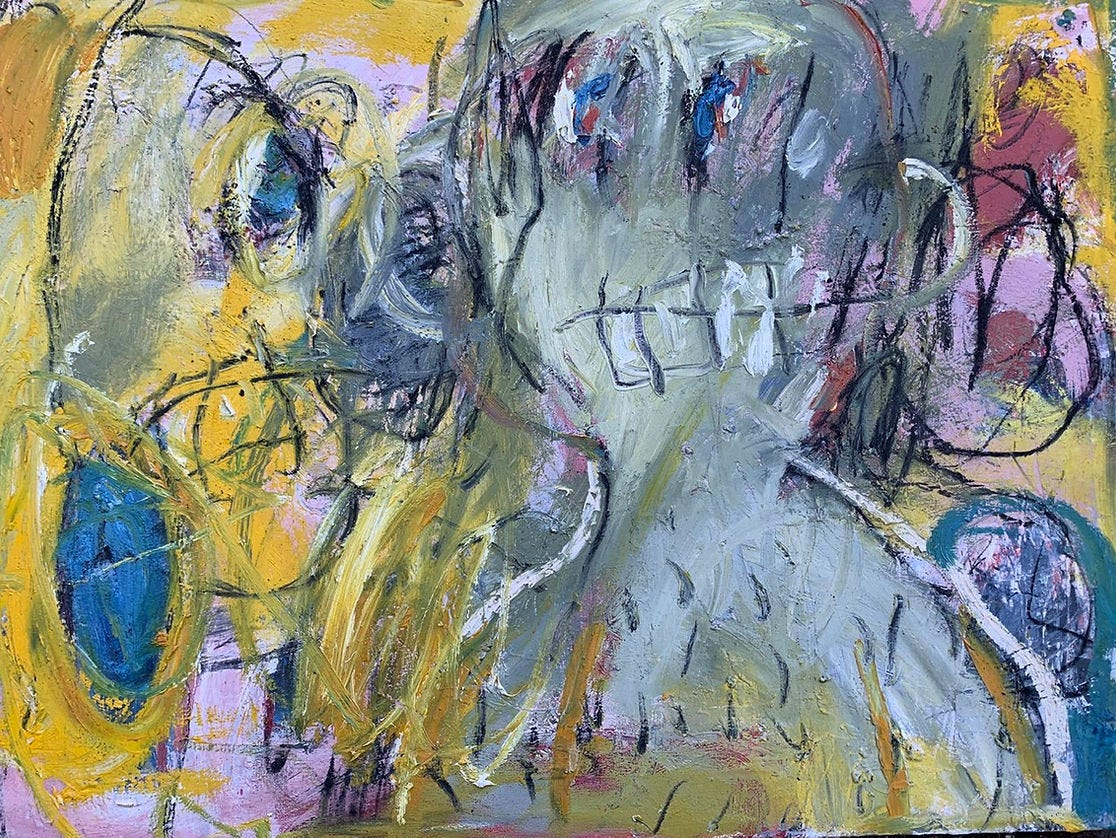
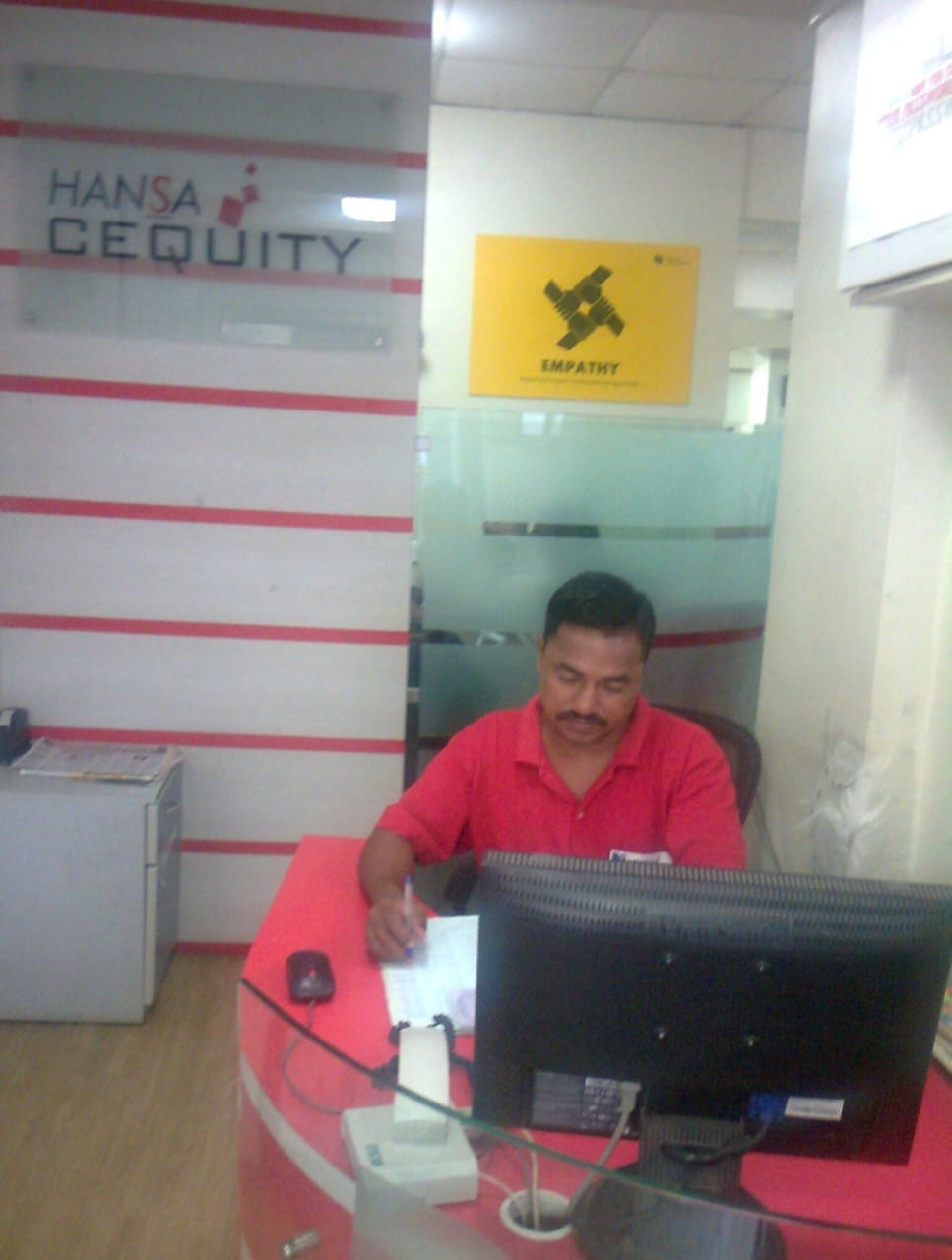
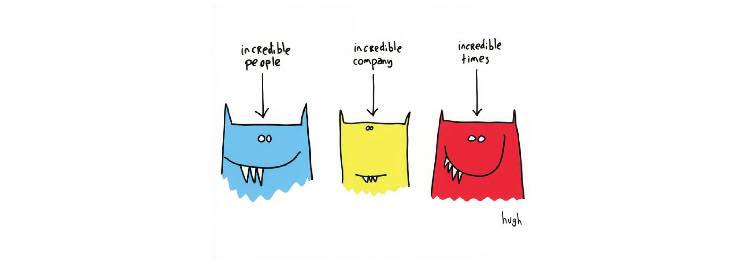

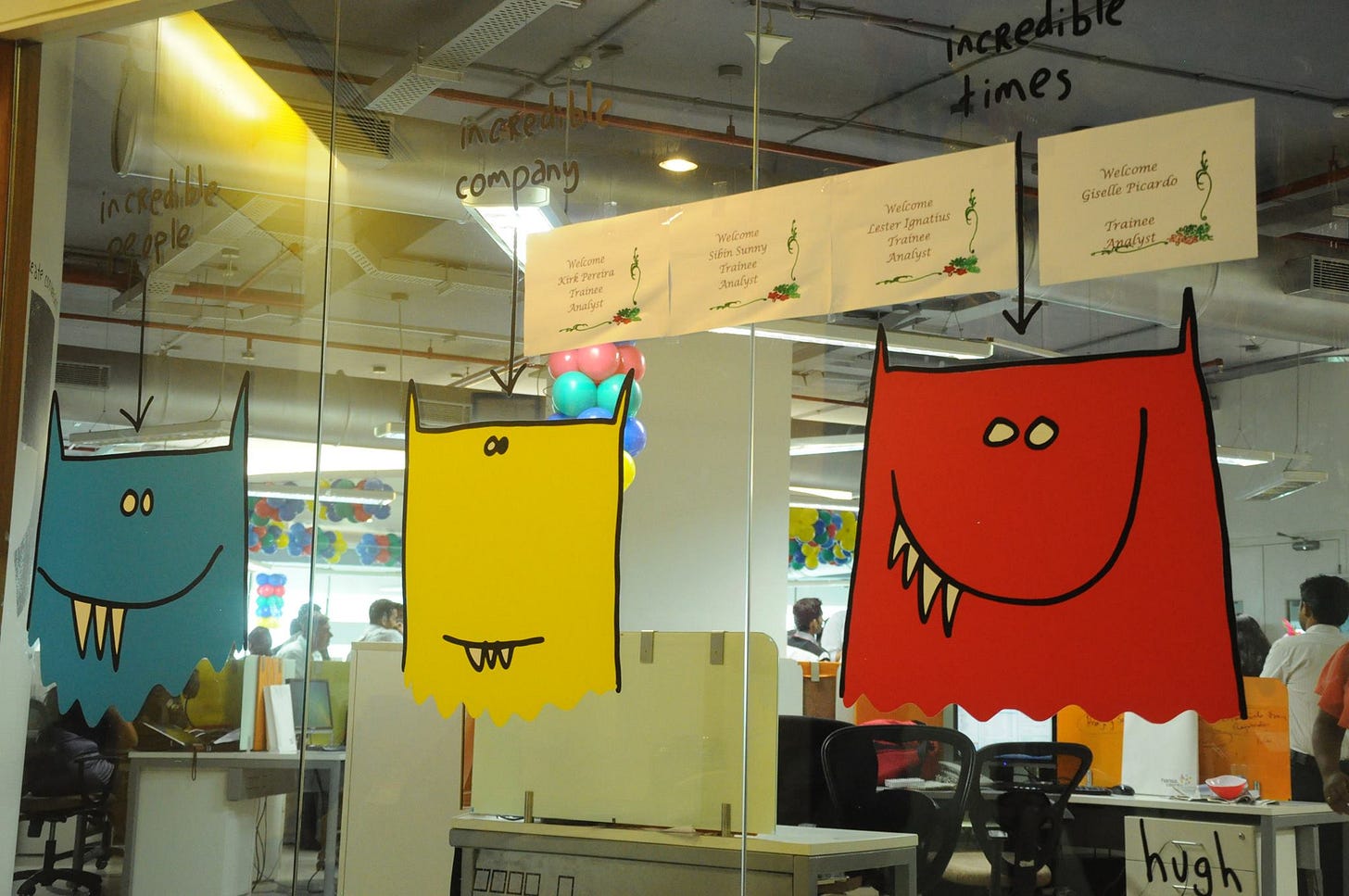

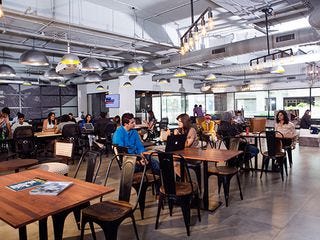
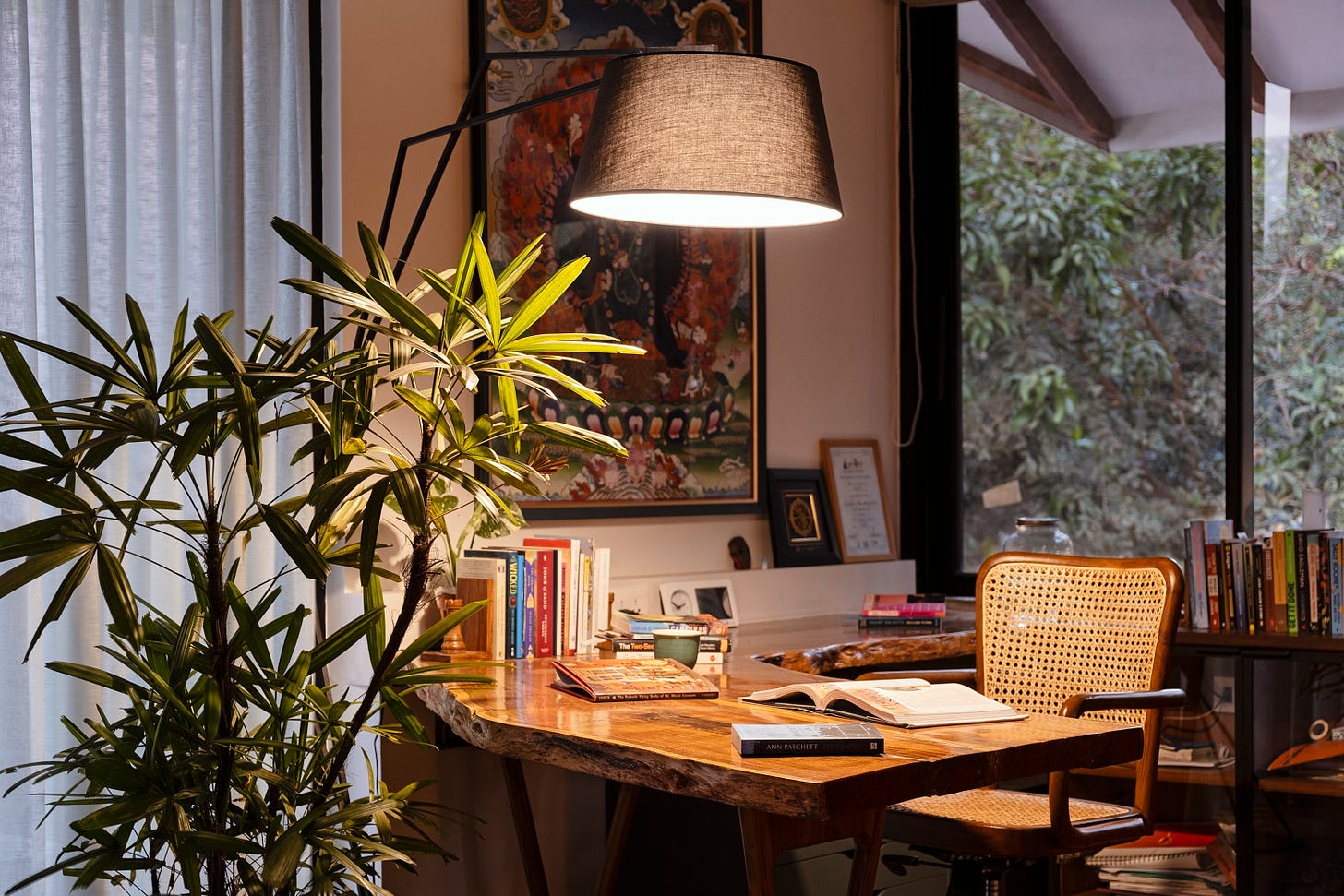
Hello Ajay, I read your write up with great interest ,as ,I have witnessed you going through all of the details there in! I liked it very much, keeping the spirit of positiveness , you have been very honest in expressing your experiences.
I loved the ideas of your office in Cequity , they are very new and freedom giving.
And, I love your ideas now, of working from your room gazing at the greenery!
Mom
Another brilliant piece! I I enjoyed reading it and your words really made me pause and think.
Could you please do a piece on the people that filled those spaces...how they impacted you and another piece on the decisions...the best the worst...the easiest and toughest...made in those spaces? Thanks!